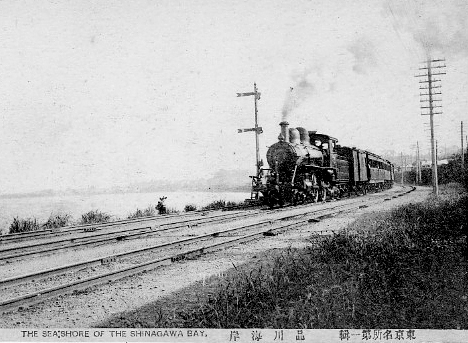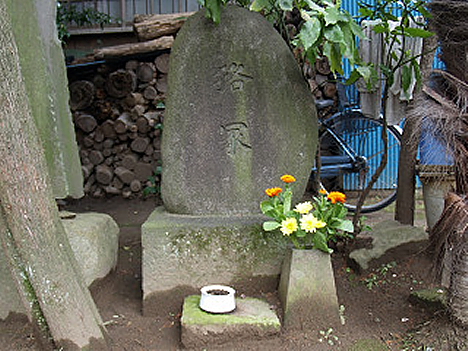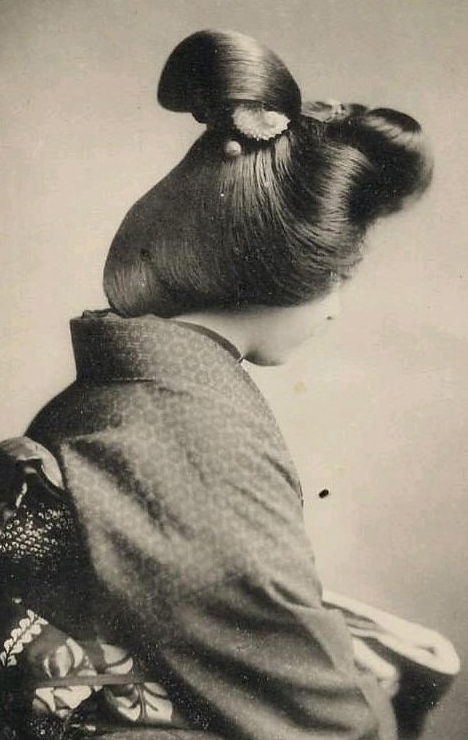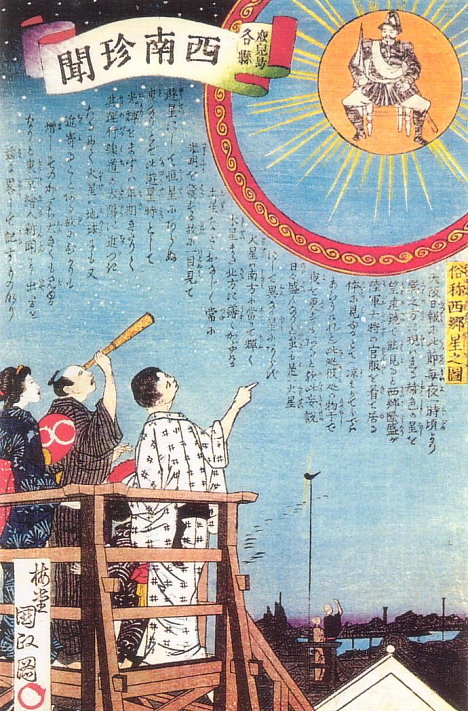An animated short about post-apocalyptic ant people, directed by Ryō Hirano.
Archives: 2010
Photos of Sakurajima volcano
On a recent visit to Japan, alien landscape photographer Martin Rietze captured some spectacular images of Sakurajima volcano in Kagoshima prefecture.

Multiple lightning flashes caused by fast moving fine ash

Lava bombs hitting the flank

Strombolian eruption with lightning

Detail with multiple lightning flashes

Lava brightens the ash cloud

Ash eruption causing lightning

Violent eruption

The photos were taken between December 24, 2009 and January 10, 2010.
[Link: Martin Rietze]
Urban legends from Meiji-period Japan
In the Meiji period (1868-1912), Japan ended centuries of isolation and entered a period of rapid modernization after opening its doors to the world. The ensuing social and technological changes inspired a number of interesting urban legends.
- Phantom trains
Railroads played a key role in the modernization of Japan. After the first trains started running in 1872, railroads quickly expanded across the country. But as the number of trains increased, so did the frequency of phantom train sightings.

Most often seen by train conductors working late at night, these phantom trains -- which looked and sounded like ordinary trains -- tended to emerge suddenly from the darkness ahead. Shocked by the sight of an oncoming locomotive, conductors typically reacted by grinding their train to halt. Phantom trains usually vanished just before a collision occurred.
These phantom trains, whose sightings have been documented by scholars such as ethnologist Kunio Yanagita and folklorist Kizen Sasaki, were often thought to be the work of shape-shifting animals such as the kitsune (fox), tanuki (raccoon dog) and mujina (badger), because the carcasses of these animals would often be found near where sightings took place.
According to one old Tokyo tale, a phantom train used to appear frequently on the Jōban line. One night, while passing through Tokyo's Katsushika ward, a conductor spotted the notorious phantom train barreling toward him. Convinced it was nothing more than an illusion, he kept charging ahead without applying the brakes. At the moment of impact, there was a loud shriek as the phantom train disappeared into thin air.
The next morning, a number of mangled badger carcasses were found scattered near the tracks where the sighting occurred. The nearby residents surmised that the badgers had banded together and shape-shifted into a menacing-looking train in revenge for being displaced from their homes. A burial mound was constructed for the badgers at Kenshōji temple in Kameari.

Mujina-dzuka (badger mound) monument at Kenshōji temple in Tokyo
A stone monument marking the spot of the badger burial mound can still be seen at the temple today.
* * * * *
- Electric power lines insulated with the blood of virgins
Like the railroads, electricity played a vital role in the modernization of Japan during the Meiji period. The spread of electricity brought overhead power lines to cities and towns across the country. These new additions to the landscape were regarded with suspicion by many, and they became the subject of various rumors.
Coal tar was used as insulation for electric wires in the early days. Somehow, rumors began to circulate that the thick dark insulating substance was derived from the blood of innocent young women. At the height of the rumors, many virgins were afraid to go outside, fearing they would have their blood stolen for use on the wires. Those who were courageous enough to venture outdoors would sometimes disguise themselves as older, married women by wearing simple kimonos, blackening their teeth, painting their eyebrows, and doing their hair in the marumage style (rounded knot on top of the head).

Marumage hairstyle for married women
* * * * *
- Cholera-carrying electric power lines
In addition to instilling fear in young women, power lines were also thought to transmit the dreaded cholera, which claimed hundreds of thousands of lives in Japan during the Meiji period. According to the word on the street, a person could contract cholera simply by walking under overhead power lines. If circumstances forced you to pass beneath a power line, you could protect yourself by holding an open folding fan over your head.
* * * * *
- Chocolate made from cow blood
The Meiji period also saw the birth of the chocolate industry. Although Japan's first taste of chocolate came in the 18th century via Dutch traders at Nagasaki, it was not until 1878 that Fugetsudo, a sweets manufacturer, produced the first Japanese chocolate. The novel taste was a hit, and other manufacturers quickly followed suit. Despite the early success, however, the exotic sweet had its doubters. Sales suffered a setback at the end of the century after rumors circulated that chocolate was made from coagulated cow blood.
* * * * *
- Saigō star
In 1877, in the aftermath of the Satsuma Rebellion -- an armed revolt of ex-samurai against the Meiji government -- a rumor spread that fallen samurai leader Takamori Saigō could be seen in the night sky.

Saigō star (woodblock print by Kunimasa Umedo)
In September of that year, Earth reached its closest point to Mars (about 56 million kilometers), causing it to shine big and bright at night. Not realizing the strange red light was Mars, many regarded the star as an ill omen for Saigō's enemies. Rumors claimed that Saigō could be seen in full military dress in the star when viewed through a telescope. Woodblock prints depicting the so-called Saigō star were popular at the time.
[Note: This is the latest in a series of weekly posts on Japanese urban legends. Check back next week for more.]
Dance, kappa, dance
Japan's legendary kappa grooves it up in the new animated music video by electropop group Omodaka.
For more kappa coolness, check out the video for "MOGU MOGU" by Chinza Dopeness, directed by Fantasista Utamaro. (Thanks, chee!)
Rent a rowboat, wreck a relationship
At first glance, a romantic ride in a rowboat might seem like a pleasant activity for lovers. Lakes and ponds across Japan commonly offer boats for rent, making them popular spots for couples on a date. But beware: these ponds are often dogged by superstitions claiming that couples who venture out in the boats are doomed to break up after they return to shore.

Empty rowboats at Inokashira Park
One of the most notorious relationship-wrecking boat ponds is at Inokashira Park in western Tokyo. The pond is located next to a small shrine dedicated to Benzaiten, the goddess of all things that flow (including water, speech, music and money). According to local legend, the goddess has a vengeful jealous streak that compels her to split up the happy couples in the rowboats. However, it is said that Benzaiten spares those who pay a visit to the nearby shrine after their boat ride.
Another boat pond known for jinxing relationships is at Higashiyama Park in Nagoya. The superstition at this park appears to be linked to an old legend involving a dragon living in the pond. According to the old story, the dragon was able to fly high into the sky to fetch magical water that could wipe away a person's sad memories. The story has evidently mutated over time, and the water that once enabled people to forget their sadness now causes people to forget their relationships. Interestingly, the park has tried to make hay of the superstition by offering free boat rentals to courageous couples in February during the Valentine's season.
Similar superstitions haunt boat ponds nationwide, including Nakajima Park in Sapporo, Shinobazu Pond in Tokyo, Shakujii Park in Tokyo, Omiya Park in Saitama, Lake Senba in Mito, Maruyama Park in Kyoto, Takaraga-ike Park in Kyoto, Arashiyama near Kyoto, the pond at Okayama Castle (the swan boats), Tokiwa Park in Ube, Takinomiya Park in Niihama, and Ohori Park in Fukuoka (only dangerous if you pass under the bridge). Undoubtedly there are others.
Although these superstitious claims are not supported by evidence, they are enough to make some people think twice before jumping into a rowboat with their sweetheart.
[Note: This is the latest in a series of weekly posts on Japanese urban legends. Check back next week for more.]
London dekochari
A dazzling dekochari art bike has been spotted on the streets of East London.
+ Video
Built in a mere five weeks by London resident Charlie Hope and friends, this dekochari features a flashy light display and a body of precision-cut aluminum sheeting that has been hand-folded and riveted to a steel frame.
The music in the video is "Ichiban-boshi Blues" (vocals by Bunta Sugawara and Kinya Aikawa), the theme song from the Torakku Yarou movie series that sparked Japan's dekotora art truck craze in the '70s, which in turn inspired the dekochari phenomenon.
[See also: Dekochari art bikes (video)]
Vintage Japanese industrial expo posters
Here is a collection of posters from various expositions held in Japan in the 1920s to 1940s.

National Industrial Exhibition - Himeji, 1926 [+]

National Products Progress Exhibition - Sapporo, 1926 [+]

Grand Exposition in Commemoration of the Imperial Coronation - Kyoto, 1928 [+]

Sea and Air Exhibition - Tokyo, 1930 [+]

Sea and Air Exhibition - Tokyo, 1930 [+]

The National Products Progress Exhibition - Kagoshima, 1931 [+]

National Horse Exhibition - Osaka, 1933 [+]

Tourism Industry Exhibition - Nara, 1933 [+]

Yokohama Exposition - Yokohama, 1935 [+]

National Exposition - Iga-Ueno, 1935 [+]

National Defense and Resources Exposition - Himeji, 1936 [+]

National Defense and Resources Exposition - Himeji, 1936

National Defense and Resources Exposition - Himeji, 1936

Exposition Commemorating Hakata Port Construction - Fukuoka, 1936 [+]

Exposition Commemorating the Construction of Hakata Port - Fukuoka, 1936 [+]

Japan-Manchuria Industrial Exhibition - Toyama, 1936 [+]

Nagoya Pan-Pacific Peace Exposition - Nagoya, 1937 [+]

Nagoya Pan-Pacific Peace Exposition - Nagoya, 1937 [+]

Nangoku Tosa Exhibition - Kochi, 1937 [+]

International Hot Spring Tourism Exposition - Beppu, 1937 [+]

Second Sino-Japanese War Exhibition - Osaka, 1938 [+]

Greater East Asia Construction Exposition - Osaka, 1939 [+]

National Defense Science Exposition - Tokyo/Kanagawa, 1940 [+]

National Defense Science Exposition - Hyogo, 1941 [+]

National Defense Science Exposition - Hyogo, 1941

National Defense Science Exposition - Hyogo, 1941

Asia Development and Defense Exposition - Toyota City, 1941 [+]
[Via: Nihon no Hakurankai, published by Heibonsha Limited, 2005]
Video: Tiger on the loose at Ueno Zoo
A tiger ran wild through Tokyo's Ueno Zoo yesterday as part of a biannual escaped animal drill.
+ Video
This year's simulation involved a tiger that escaped after an earthquake. The runaway animal -- played by a person in a suit -- caused some chaos and took down a couple of onlookers before the zoo staff chased it down, surrounded it with nets, and shot it with a tranquilizer dart.
Eromanga Island has disappeared
Eromanga Island, a tiny island in the South Pacific nation of Vanuatu, has been swallowed up by rising sea levels, according to a long-standing rumor in Japan.

View of Eromanga Island on the Wii weather channel
Erroneous news about the island's watery demise appears to have begun ten years ago as a tidbit of fake trivia presented on a popular late-night TBS Radio program hosted by comedian Hikaru Ijuin. Some listeners apparently took the information at face value, and word of Eromanga's fate began to spread. The rumors were further fueled when a subsequent TV program mentioned Eromanga as an example of an island that had been submerged by rising sea levels caused by global warming.
Years later, some people still evidently believe Eromanga has disappeared.
To Japanese speakers, the name of the island might sound more incredible than the rumors of its disappearance. Eromanga (エロマンガ) happens to be the Japanese word for erotic manga (i.e. "porno comics"). The unlikely name, which conjures up images of an exotic place overflowing with adult comic magazines, even inspired Osamu Tezuka, the godfather of manga, to take a trip there with fellow manga creator Ichiro Tominaga.
In the local language, Eromanga (also spelled Erromanga or Erromango) means "it's a man."

Interestingly, there is an element of truth to the rumors of Eromanga's disappearance. In recent years, Japanese map makers have adopted a new spelling -- イロマンゴ (pronounced "iromango") -- which appears to more accurately reflect the native pronunciation. So even though Eromanga has not been swallowed up by the sea, it has, in a sense, been wiped off the map.
[Note: This is the latest in a series of weekly posts on Japanese urban legends. Check back next week for more.]
